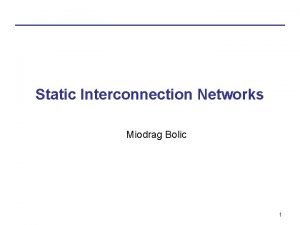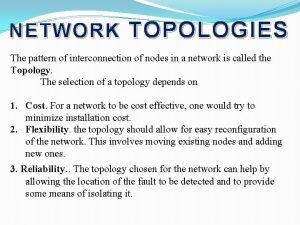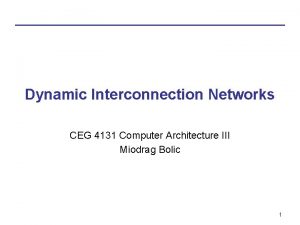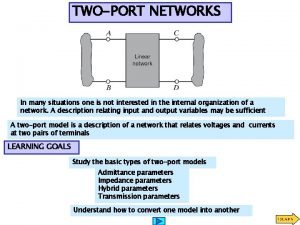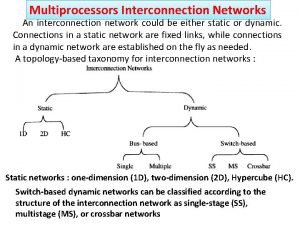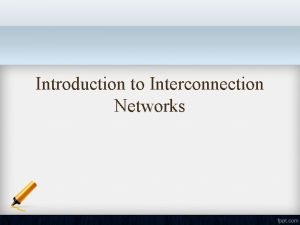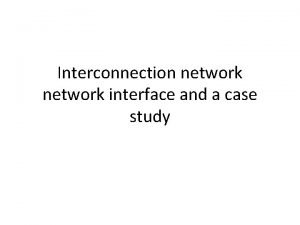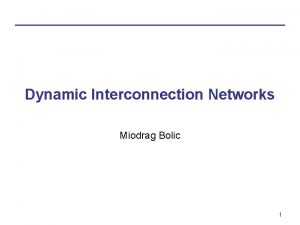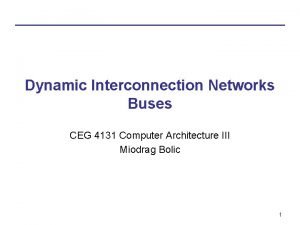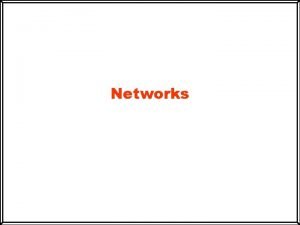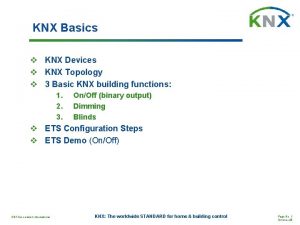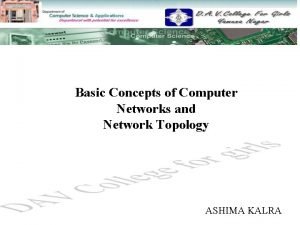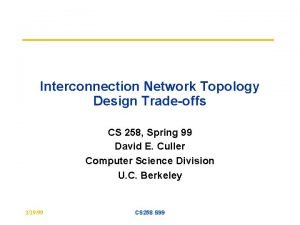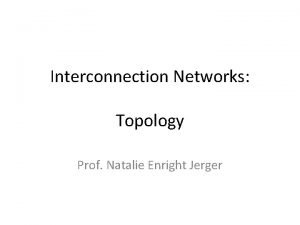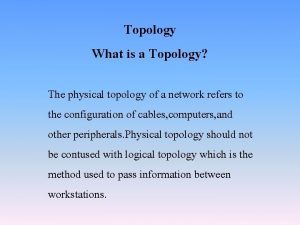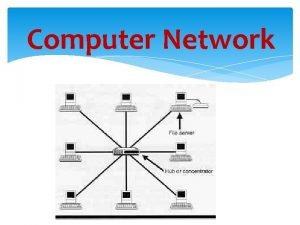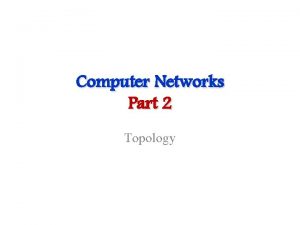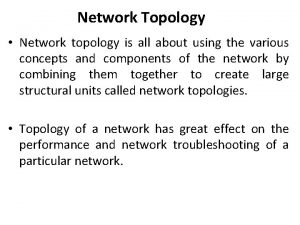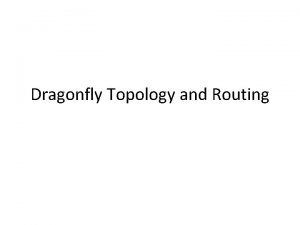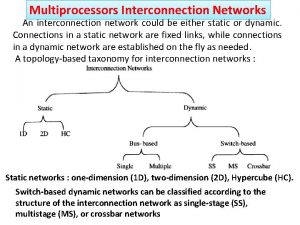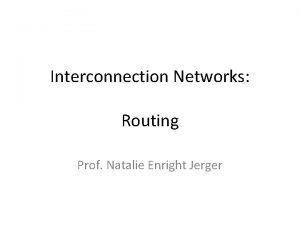Interconnection Network Routing Topology Design Tradeoffs Adopted from


























- Slides: 26

Interconnection Network Routing, Topology Design Trade-offs Adopted from CS 258, Spring 99 U. C. Berkeley Notes 3/19/99 CS 258 S 99

Interconnection Topologies • Class networks scaling with N • Logical Properties: – distance, degree • Physical properties – length, width • Static vs. Dynamic Networks • Fully connected network – diameter = 1 – degree = N – cost? » bus => O(N), but BW is O(1) - actually worse » crossbar => O(N 2) for BW O(N) • VLSI technology determines switch degree 3/19/99 CS 258 S 99 2

Example Static Network: 2 -D Mesh Architecture 3/19/99 CS 258 S 99 3

Dynamic Network Consists of Switches Switch Components • Output ports – transmitter (typically drives clock and data) • Input ports – synchronizer aligns data signal with local clock domain – essentially FIFO buffer • Crossbar – connects each input to any output – degree limited by area or pinout • Buffering • Control logic – complexity depends on routing logic and scheduling algorithm – determine output port for each incoming packet – arbitrate among inputs directed at same output 3/19/99 CS 258 S 99 4

Switches A 4 X 4 Crossbar Switch at a node 3/19/99 CS 258 S 99 5

More Static Networks: Linear Arrays and Rings • Linear Array – – Diameter? Average Distance? Bisection bandwidth? Route A -> B given by relative address R = B-A • Torus? • Examples: FDDI, SCI, Fiber. Channel Arbitrated Loop, KSR 1 3/19/99 CS 258 S 99 6

Multidimensional Meshes and Tori 3 D Cube 2 D Grid • d-dimensional array – n = kd-1 X. . . X k. O nodes – described by d-vector of coordinates (id-1, . . . , i. O) • d-dimensional k-ary mesh: N = kd – k = dÖN – described by d-vector of radix k coordinate • d-dimensional k-ary torus (or k-ary d-cube)? Ex: Intel Paragon (2 D), SGI Origin (Hypercube), Cray T 3 E (3 DMesh) 3/19/99 CS 258 S 99 7

Example: k-ary 2 D array • Theorem: x, y routing is deadlock free • Numbering – – +x channel (i, y) -> (i+1, y) gets i similarly for -x with 0 as most positive edge +y channel (x, j) -> (x, j+1) gets N+j similarly for -y channels • any routing sequence: x direction, turn, y direction is increasing 3/19/99 CS 258 S 99 8

Hypercubes • • Also called binary n-cubes. # of nodes = N = 2 n. O(log. N) Hops Good bisection BW Complexity – Out degree is n = log. N correct dimensions in order – with random comm. 2 ports per processor 0 -D 1 -D 3/19/99 2 -D 3 -D 4 -D CS 258 S 99 5 -D ! 9

Routing in Hypercube N = 26 nodes S = (sn-1 sn-2… si …s 2 s 1 s 0) D = (dn-1 dn-2… di… d 2 d 1 d 0) E-cube routing For i=0 to n-1 Compare si and di Route along i dimension if they differ. Distance = Hamming distance between S and D = the no. of dimensions by which S and D differ. Diameter = Maximum distance = n = log 2 N = Dimension of the hypercube No. of alternate parts = n Fault tolerance = (n-1) = O(log 2 N) 3/19/99 CS 258 S 99 000=>001=>011=>111 000=>010=>111 000=>101=>111 10

Properties • Routing – relative distance: R = (b d-1 - a d-1, . . . , b 0 - a 0 ) – traverse ri = b i - a i hops in each dimension – dimension-order routing • Average Distance Wire Length? – d x 2 k/3 for mesh – dk/2 for cube • Degree? • Bisection bandwidth? Partitioning? – k d-1 bidirectional links • Physical layout? – 2 D in O(N) space – higher dimension? 3/19/99 Short wires CS 258 S 99 11

Trees • Diameter and ave distance logarithmic – k-ary tree, height d = logk N – address specified d-vector of radix k coordinates describing path down from root • Fixed degree • Route up to common ancestor and down – R = B xor A – let i be position of most significant 1 in R, route up i+1 levels – down in direction given by low i+1 bits of B • H-tree space is O(N) with O(ÖN) long wires 3/19/99 CS 258 S 99 • Bisection BW? 12

Fat-Trees • Fatter links (really more of them) as you go up, so bisection BW scales with N EX: CM 5 3/19/99 CS 258 S 99 13

Butterflies building block 16 node butterfly • • Tree with lots of roots! N log N (actually N/2 x log. N) Exactly one route from any source to any dest R = A xor B, at level i use ‘straight’ edge if ri=0, otherwise cross edge (d-1)/d • Bisection N/2 vs n 3/19/99 CS 258 S 99 14

k-ary d-cubes vs d-ary k-flies • • degree d N switches vs N log N switches diminishing BW per node vs constant requires locality vs little benefit to locality • Can you route all permutations? 3/19/99 CS 258 S 99 15

Relationship Bttr. Flies to Hypercubes • Wiring is isomorphic • Except that Butterfly always takes log n steps 3/19/99 CS 258 S 99 16

Toplology Summary Topology Degree Diameter Ave Dist Bisection D (D ave) @ P=1024 1 D Array 2 N-1 N/3 1 huge 1 D Ring 2 N/4 2 2 D Mesh 4 2 (N 1/2 - 1) 2/3 N 1/2 63 (21) 2 D Torus 4 N 1/2 2 N 1/2 32 (16) nk/2 nk/4 15 (7. 5) @n=3 n n/2 N/2 k-ary n-cube 2 n Hypercube n =log N 10 (5) • All have some “bad permutations” – many popular permutations are very bad for meshs (transpose) – ramdomness in wiring or routing makes it hard to find a bad one! 3/19/99 CS 258 S 99 17

Real Machines Machine Topology Cycle Time (ns) Channel Width (bits) Routing Delay (cycles) Flit (data bits) n. CUBE/2 Hypercube 25 1 40 32 TMC CM-5 Fat-Tree 25 4 10 4 IBM SP-2 Banyan 25 8 5 16 Intel Paragon 2 D Mesh 11. 5 16 2 16 Meiko CS-2 Fat-Tree 20 8 7 8 CRAY T 3 D 3 D Torus 6. 67 16 2 16 DASH Torus 30 16 2 16 J-Machine 3 D Mesh 31 8 2 8 Monsoon Butterfly 20 16 2 16 SGI Origin Hypercube 2. 5 20 16 160 Myricom Arbitrary 6. 25 16 50 16 • Wide links, smaller routing delay • Tremendous variation 3/19/99 CS 258 S 99 18

How Many Dimensions? • n = 2 or n = 3 – Short wires, easy to build – Many hops, low bisection bandwidth – Requires traffic locality • n >= 4 – Harder to build, more wires, longer average length – Fewer hops, better bisection bandwidth – Can handle non-local traffic • k-ary d-cubes provide a consistent framework for comparison – N = kd – scale dimension (d) or nodes per dimension (k) – assume cut-through 3/19/99 CS 258 S 99 19

Traditional Scaling: Latency(P) • Assumes equal channel width – independent of node count or dimension – dominated by average distance 3/19/99 CS 258 S 99 20

Average Distance • ave dist = d (k-1)/2 • Higher dimension => more channels 3/19/99 CS 258 S 99 21

Equal cost in k-ary n-cubes • • Equal number of nodes? Equal number of pins/wires? Equal bisection bandwidth? Equal area? Equal wire length? What do we know? • switch degree: d diameter = d(k-1) • total links = Nd • pins per node = 2 wd • bisection = kd-1 = N/k links in each directions • 2 Nw/k wires cross the middle 3/19/99 CS 258 S 99 22

Discussion • Rich set of topological alternatives with deep relationships • Design point depends heavily on cost model – nodes, pins, area, . . . – Wire length or wire delay metrics favor small dimension – Long (pipelined) links increase optimal dimension • Need a consistent framework and analysis to separate opinion from design • Optimal point changes with technology 3/19/99 CS 258 S 99 23

Origin 2000 System Overview • • Single 16”-by-11” PCB Directory state in same or separate DRAMs, accessed in parallel Upto 512 nodes (1024 processors) With 195 MHz R 10 K processor, peak 390 MFLOPS or 780 MIPS per proc • Peak Sys. AD bus bw is 780 MB/s, so also Hub-Mem • Hub to router chip and to Xbow is 1. 56 GB/s (both are off-board) 3/19/99 CS 258 S 99 24

Origin Network • Each router has six pairs of 1. 56 MB/s unidirectional links – Two to nodes, four to other routers – latency: 41 ns pin to pin across a router • Flexible cables up to 3 ft long • Four “virtual channels”: request, reply, other two for priority or I/O 3/19/99 CS 258 S 99 25

Case Study: Cray T 3 D • Build up info in ‘shell’ • Remote memory operations encoded in address 3/19/99 CS 258 S 99 26
 Design tradeoffs for ssd performance
Design tradeoffs for ssd performance Types of network topology
Types of network topology Flood routing lecture notes
Flood routing lecture notes Static routing and dynamic routing
Static routing and dynamic routing Continuity equation hydrology
Continuity equation hydrology Clock and power routing in vlsi
Clock and power routing in vlsi Static interconnection networks
Static interconnection networks Static interconnection network in computer architecture
Static interconnection network in computer architecture Star topology advantages and disadvantages
Star topology advantages and disadvantages Baseline network in computer architecture
Baseline network in computer architecture Interconnection of two port network
Interconnection of two port network Dynamic interconnection network in computer architecture
Dynamic interconnection network in computer architecture Lara srivastava
Lara srivastava Network interconnection studies
Network interconnection studies Miodrag bolic
Miodrag bolic Dynamic interconnection network in computer architecture
Dynamic interconnection network in computer architecture Examples of tradeoffs
Examples of tradeoffs Scarcity forces tradeoffs symbol
Scarcity forces tradeoffs symbol Physical topologies
Physical topologies Wide area network topology
Wide area network topology Ppt network topology
Ppt network topology Mpls network topology
Mpls network topology Topology knx
Topology knx Interconnect topology
Interconnect topology Network topology summary
Network topology summary Star and mesh topology
Star and mesh topology Commvault communication ports
Commvault communication ports






